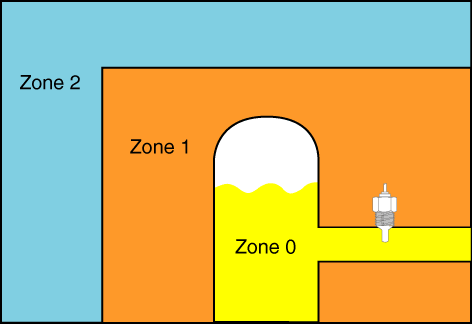ATEX Certification Process: |  | |
General:
The Safety, Health and Welfare at Work (General Application) Regulations 2007, Part 8: Explosive Atmospheres at Places of Work state that
"Before a workplace containing a place that is classified as hazardous is used for the first time, an employer shall ensure that the overall explosion safety of the workplace is verified by a competent person"
This ATEX Verification Guide and the associated ATEX Certificates provides a template to assist with the verification that all the relevant standards and requirements have been considered and complied with, where appropriate. The Health and Safety Authority Guide to the above regulations is available for download at: Guide to the Safety, Health and Welfare at Work (General Application) Regulations 2007 Competence |

| |
The employer responsible for the installation must ensure that the verification process is carried out by a competent person.
The competent person does not necessarily need to be independent of the project. The same competent person does not need to verify all aspects of the project. The term "competent person" is defined in the 2005 Safety Health and Welfare at Work Act as someone who "possesses sufficient training, experience and knowledge appropriate to the nature of the work to be undertaken" The installer of new equipment, the final user or an independent person may carry out the verification. The person selected must have sufficient practical and theoretical knowledge from actual experience and professional training relevant to the particular workplace and work activity. |
Area Classification |  | |
The Safety, Health and Welfare at Work Regulations referred to above, requires an employer to: "classify places at the workplace where explosive atmospheres may occur into hazardous or non-hazardous places" This area classification exercise defines the level of risk in each area and determines the appropriate ATEX Equipment Category, Gas Group and Temperature Class for each area. The Area Classification documentation will normally comprise the Area Classification Report and accompanying drawings. While the drawings are a useful indication of the extent of hazardous areas, the Area Classification Report will provide the details of each potential source of release and the classification and dimensions of the resulting ATEX areas. The Area Classification documentation will form part of the Explosion Protection Document. ATEX Certification Template | 
| |
Guide
The ATEX Certification Template may be used to record general project information about the installation or project, relevant to the specific measures aimed at ensuring safety. Sample ATEX Project Details Certificate Page 1 of 2 Sample ATEX Project Details Certificate Page 2 of 2 Only those sections relevant to the project should be completed by the person responsible for the relevant installation. In all cases, the ATEX Registers should be completed with details of all certified equipment installed in ATEX areas. Sample ATEX Equipment Register Sample ATEX Electrical Register Sample ATEX Instrumentation Register |
Equipment Assemblies | 
|
|
The following are examples of types of equipment requiring ATEX certification to the Category appropriate to the area in which they are installed:
Mechanical Equipment | Examples |
Mechanical equipment having its own source of ignition | This includes rotating or moving equipment such as fans, pumps, conveyors, gearboxes In general, slow moving equipment such as valves, check valves, pneumatic actuators do not have their own source of ignition and do not require certification |
Mechanical equipment and devices without any inherent ignition source but which act as protective devices with respect to explosion safety | Rotary valves, used for explosion isolation; Flame arrestors; Explosion relief panels; Explosion isolation or suppression systems |
Equipment assemblies or skids. These are generally an assembly of certified mechanical and electrical equipment Refer to IEC TS 60079-46:2017 Explosive atmospheres - Part 46: Equipment assemblies A Declaration of Conformity is required to confirm that the assembly does not introduce any additional ignition hazards which may not have been foreseen not in the individual equipment assessments | Centrifuges Motor/Pump combinations |
| In many cases, the basis of safety for mechanical equipment will depend on monitoring of some parameter within the system | Fluid flow in a centrifugal pump; Seal temperature on an agitator; Liquid level in a vacuum pump |
The requirements for monitoring will be specified on the equipment certificate, or in most cases, in the ATEX Addendum to the Installation and Operating Manual.
The functional safety requirements for the monitoring system (e.g. SIL1, SIL2 etc) will also be specified.
Verification of the mechanical equipment requires verification of the monitoring systems and of the associated functional safety system.
The details and documentation of the Equipment Assemblies Verification should be recorded on the Mechanical Equipment Systems Forms:
Hazardous Area Completion Certificate - Equipment & Assemblies Part 1 of 3
Hazardous Area Completion Certificate - Equipment & Assemblies Part 2 of 3
Hazardous Area Completion Certificate - Equipment & Assemblies Part 3 of 3
Ventilation Systems
The type and extent of ATEX areas is often determined by the availability and effectiveness of ventilation. For outdoor areas, standard assumptions are made. For indoor areas, the Hazardous Area Classification Report (HAC) may contain assumptions or specifications regarding the provision or availability of mechanical ventilation.
Refer to I.S. EN 60079-10-1 Table D1
Verification of the ventilation systems in ATEX areas is required to confirm that design and performance requirements of the ventilation systems have been met - for example:
Possible Requirement | Verification |
| Continuous availability | Ventilation always on with alarms or auto changeover on failure / low air flow
|
| Boost | Boost systems to increase airflow in response to the detection of a release are in place and effective |
| Recirculation | Recirculation of exhaust air is not normally permitted in Zone 1 areas In Zone 2 areas recirculation of exhaust air may require a detection system to switch to full exhaust in response to a release. Any such systems should be verified |
| Alarm Annunciation | Activates in the event of ventilation failure. |
| Air Changes | Required air change rate has been achieved in normal and boost modes |
| Location | Extract points for vapour areas at low level ATEX zone around exhaust point |
| Local exhaust (LEV) | Local exhaust ventilation installed at specified locations |
| Extract | Extract fans and extract dust instrumentation verified for ATEX compliance |
The details and documentation of the Ventilation Systems Verification should be recorded on the Ventilation Systems Forms:
Hazardous Area Completion Certificate - Ventilation Systems Part 1 of 3
Hazardous Area Completion Certificate - Ventilation Systems Part 2 of 3
Hazardous Area Completion Certificate - Ventilation Systems Part 3 of 3
Electrical Systems Verification The basic requirements for the design, installation, testing and documentation of all electrical installations are specified in I.S. 10101 National Rules for Electrical Installations The additional requirements for electrical equipment and installations ATEX areas are defined in I.S. EN 60079-Part 14: Electrical installations design, selection and erection. These requirements are in addition to those in I.S. 10101. I.S. EN 60079-14 also provides a detailed description of the requirements for verification of electrical installations in ATEX areas. This standard specifies a Verification Dossier must be produced to confirm that the electrical equipment and installation complies with relevant standards in addition to any instructions from the equipment manufacturer, and any relevant 'special conditions for safe use' specified on the equipment certificate. The Verification Dossier may be a hard copy file or a computer file and should contain the following information, where applicable: Contents of ATEX Verification Dossier. The details and documentation of the Electrical Systems Verification should be recorded on the Electrical Systems Forms: Hazardous Area Completion Certificate - Electrical Systems Part 1 of 3 Hazardous Area Completion Certificate - Electrical Systems Part 2 of 3 Hazardous Area Completion Certificate - Electrical Systems Part 3 of 3 |
Client Handover:
CLIENT ATEX HANDOVER CERTIFICATE
Following completion of a project, the installation should be taken in charge by the client .The attached handover sheet provides a formal mechanism for the handover of control of the installation to the client.
Hazardous Area Completion Certificate - Client ATEX Handover Part 1 of 1